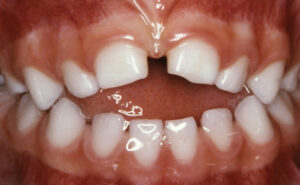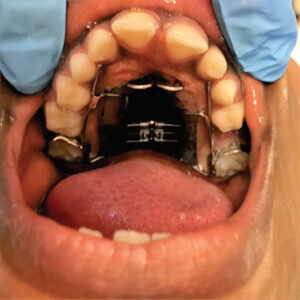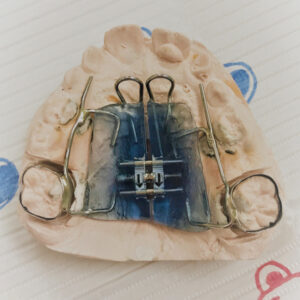
Clinical Assessment of Nonnutritive Sucking
The sequelae associated with this behavior can have negative oral health consequences, so clinicians should be positioned to offer behavior and orthodontic cessation strategies.
Nonnutritive sucking habit (NNSH) is a sucking behavior that does not result in nourishment. Common objects include thumbs, fingers, toys and pacifiers. While it is considered normal in infants and toddlers, some children engage in an NNSH beyond this period of life.1 This prolonged habit can impair the child’s orofacial development.2 This article will explore the sequelae associated with NSSHs, clinical assessment techniques, and cessation strategies.

During infancy, nutritive and nonnutritive sucking behaviors are healthy and provide an appropriate method to self-soothe.3 However, some children use sucking behaviors as a primary means to cope with stress well beyond infancy,4 and after the age of 3 children are at risk for issues in orofacial dental development. External pressure from NNSHs can result in abnormal bony growth that includes a narrowed maxilla, posterior crossbite or anterior open bite (Figure 1).5 The type of NNSH can also influence the severity of the resulting malocclusion; for example, pacifier use may be more detrimental than thumb-sucking.6 A prolonged NNSH can also be linked with problems other than malocclusion. Inadequate lip tone, which can result in speech issues, is associated with NNSHs.3 Additionally, recurrent oral contact with fingers can transmit bacterial and viral infections.7,8
As part of a routine examination in young children, dental providers should assess for prolonged NNSHs. The assessment should evaluate the intensity, duration and frequency of sucking.9 It should focus on the duration of force, as this has the largest influence on predicting malocclusion.10
The following is a list of sample questions that can be used during assessment:
Intensity
- How hard does s/he suck on his/her thumb (or other object)?
- How difficult is it to pull out of the mouth?
- Have you observed any noises associated with the habit?
- Do the cheeks sink in during thumb-sucking?
Duration
- How long does the sucking last?
- Does s/he put the thumb in and take it out, or does s/he leave it in the mouth?
Frequency
- When do you notice that thumb-sucking occurs? During the day? Nighttime? Both?
- When do you notice that it happens most? Is it when s/he is sad, bored or afraid? Is it tied to any activities (playing, watching TV or napping, for example)?

After a habit history has been taken, the clinician should evaluate the precursors to malocclusion; for example, by assessing the occlusion and focusing on the flaring of incisors and possible development of an open bite or posterior crossbite. If it is determined that malocclusion is developing, the provider should follow-up with questions about possible issues with speech and mastication.
The American Academy of Pediatric Dentistry recommends the cessation of NNSHs by age 3 or younger.9 If a child has an NNSH, the clinician should provide anticipatory guidance with the parent or caregiver. The primary goal of this counseling is to decrease or eliminate the behavior and minimize its effect on the child’s developing occlusion. These conversations should focus on cessation strategies that are developmentally appropriate and based on the child’s ability to understand and cooperate. Such strategies can be organized into two main categories: behavioral and orthodontic.
BEHAVIORAL CESSATION STRATEGIES
The most common initial strategies to modify an NNSH by parents/caregivers are behavioral. These include abrupt interruption, counseling, unpleasant flavor substances, and reminder therapy.11,12 With abrupt interruption, the adult refuses to give the child the sucking object (e.g., pacifier). This method is very common and has a moderate level of success.11 Unfortunately, it cannot be used with thumbs or fingers.
Counseling of the child, parental and professional, is a helpful tactic to modify the behavior. Of the two types, counseling by a health provider is much more successful than that performed by parents/caregivers.11 Therefore, dental providers have a strong opportunity to help cease the NNSH. The following components of counseling can be used in an age-appropriate way:
- Use positive reinforcement to praise the child for not performing the NNSH; for example, by saying, “Great job sitting in the chair without your thumb in your mouth!” Over time, the consistent use of this approach can eliminate the habit.13
- Because a child typically performs the NNSH for comfort, help find another method of soothing, such as a stuffed toy.12
- Learn the reason for the child’s anxiety and help the parent/caregiver address the cause of the insecurity.
- For an older child, provide choices in the method of stopping the NNSH.
- Provide explanations on what will happen to the child’s teeth if s/he does not stop this behavior.14
Unpleasant flavor substances can also be used to eliminate the NNSH. Aversive agents are foul-tasting liquids that can be applied to a thumb or pacifier to create an unpleasant experience. Parents/caregivers have reported this can be effective in stopping a child’s NNSH;11 however, it should serve as a reminder to stop the behavior, and not be used as a form of punishment.15
Physical barriers are useful for children who are committed to stopping the NNSH, but need help, particularly while sleeping. Examples include bandages, socks, gloves or other commercially marketed solutions. The barrier serves as a reminder and increases the difficulty for the child to engage in the behavior. Again, if the child views it as punishment, it may not be effective.15
KEY TAKEAWAYS
- A nonnutritive sucking habit (NNSH) is a sucking behavior that does not result in nourishment (e.g., thumb-sucking).
- During infancy, nutritive and nonnutritive sucking behaviors are healthy and provide an appropriate method to self-soothe,3 but the American Academy of Pediatric Dentistry recommends the cessation of NNSHs by age 3 or younger.9
- This behavior can impair orofacial development. External pressure from NNSHs, for example, can result in a narrowed maxilla, posterior crossbite or anterior open bite.5
- A prolonged NNSH can also be linked with problems beyond malocclusion.
- Dental providers should assess for NNSHs as part of a routine examination in young children.
- Behavioral and orthodontic cessation strategies are the most common ways to address an NNSH, but success will vary, depending on the individual child.19

ORTHODONTIC CESSATION STRATEGIES
The next level of cessation therapy involves the use of orthodontic appliances. The goal is to provide a fixed intraoral device that prevents the completion of the NNSH and reduces the comfort associated with the behavior. Therefore, the child learns to function daily without the habit. These appliances include a barrier that stops the thumb, finger or object from contacting the palate. They are cemented on the maxillary molars, with the barrier situated over the hard palate. One of the most common appliances is the palatal crib (Figure 2 and Figure 3).16 Other examples include the bluegrass appliance or palatal crib with spurs.17,18 These can be combined with other interceptive orthodontic appliances, such as a palatal expander. Typically, orthodontists and pediatric dentists have these appliances fabricated.9
There is a caveat to the success of these appliances. Like physical barriers, the appliance serves as a reminder to stop the behavior and as a barrier. However, the insertion of the device does not guarantee successful elimination of the behavior.19 Behavioral strategies are still needed and should focus on the child’s willingness to stop the habit. A strong desire to stop leads to a better prognosis, while a child that is not committed to stop leads to a guarded prognosis. Advise parents/caregivers that a child can still work around the barrier or deform it to allow a thumb, digit or other item to reach the palate.
Once the habit appliance is in, set a monthly recall visit to evaluate for a reduction in the frequency/elimination of the NNSH and stability of the appliance. Recementation or adjustments to the habit appliance may be needed due to forces from the NNSH. Establish a reasonable timeline with the parent/caregiver for removal of the appliance — regardless of habit elimination. If the NNSH has ceased prior to the agreed upon deadline, the habit appliance can be removed.
SUMMARY
Behavioral and orthodontic cessation strategies are the most common ways to address an NNSH, but success varies depending on the individual child.19 The key to a successful outcome is for the provider to diagnose the NNSH, assess the child’s willingness to stop, and determine which strategies work best for the patient and family.
While NNSHs are common in infants and toddlers, beyond this period of life, the behavior can be detrimental to a child’s orofacial growth. Oral health professionals should routinely look for and assess this habit in children ages 3 and older. If an NNSH is diagnosed, clinicians should focus on understanding the intensity, duration and frequency of sucking. Both behavioral and orthodontic cessation strategies should be determined in cooperation with the child and family. Ultimately, being knowledgeable about effective assessment and counseling strategies will allow clinicians to help these patients stop the behavior, and thus promote optimal orofacial development and health.
References
- Bishara SE, Warren JJ, Broffitt B, Levy SM. Changes in the prevalence of nonnutritive sucking patterns in the first 8 years of life. Am J Orthod Dentofacial Orthop. 2006;130:31–36.
- Warren JJ, Slayton RL, Bishara SE, Levy SM, Yonezu T, Kanellis MJ. Effects of nonnutritive sucking habits on occlusal characteristics in the mixed dentition. Pediatr Dent. 2005;27:445–450.
- Nelson AM. A comprehensive review of evidence and current recommendations related to pacifier usage. J Pediatr Nurs. 2012;27:690–699.
- Lookabaugh SL, Fu VR. Children’s use of inanimate transitional objects in coping with hassles. J Genet Psychol. 1992;153:37–46.
- Melink S, Vagner MV, Hocevar-Boltezar I, Ovsenik M. Posterior crossbite in the deciduous dentition period, its relation with sucking habits, irregular orofacial functions, and otolaryngological findings. Am J Orthod Dentofacial Orthop. 2010;138:32–40.
- Dogramaci EJ, Rossi-Fedele G. Establishing the association between nonnutritive sucking behavior and malocclusions: A systematic review and meta-analysis. J Am Dent Assoc. 2016;147:926–934.
- Clark DC. Common acute hand infections. Am Fam Physician. 2003;68:2167–2176.
- Kamal FG, Bernard RA. Influence of nail biting and finger sucking habits on the oral carriage of Enterobacteriaceae. Contemp Clin Dent. 2015;6:211–214.
- American Academy of Pediatric Dentistry. Management of the developing dentition and occlusion in pediatric dentistry. Pediatr Dent. 2017;39:334–347.
- Warren JJ, Bishara SE, Steinbock KL, Yonezu T, Nowak AJ. Effects of oral habits’ duration on dental characteristics in the primary dentition. J Am Dent Assoc. 2001;132:1685–1693.
- Degan VV, Puppin-Rontani RM. Prevalence of pacifier-sucking habits and successful methods to eliminate them — a preliminary study. J Dent Child (Chic). 2004;71:148–151.
- Tseng AG, Biagioli FE. Counseling on early childhood concerns: sleep issues, thumb sucking, picky eating, and school readiness. Am Fam Physician. 2009;80:139–142.
- American Academy of Pediatric Dentistry. Behavior guidance for the pediatric dental patient. Pediatr Dent. 2017;39:246–259.
- American Dental Association. Oral Health Topics A–Z. Thumbsucking. Available at: mouthhealthy.org/en/az-topics/t/thumbsucking. Accessed March 14, 2018.
- Casamassimo PS. Pediatric Dentistry: Infancy Through Adolescence. 5th ed. St. Louis, Mo: Elsevier/Saunders; 2013.
- Haryett RD, Hansen FC, Davidson PO, Sandilands ML. Chronic thumb-sucking: the psychologic effects and the relative effectiveness of various methods of treatment. Am J Orthod. 1967;53:569–585.
- Dean JA, Jones JE, Vinson LAW. McDonald and Avery’s Dentistry for the Child and Adolescent. 10th edition. St. Louis, Mo: Elsevier; 2016.
- Larsson E. Dummy- and finger-sucking habits with special attention to their significance for facial growth and occlusion. 5. Improvement of malocclusion after termination of the habit. Sven Tandlak Tidskr. 1972;65:635–642.
- Borrie FR, Bearn DR, Innes NP, Iheozor-Ejiofor Z. Interventions for the cessation of nonnutritive sucking habits in children. Cochrane Database Syst Rev. 2015(3):Cd008694.
Featured image by DAVID DE LOSSY/PHOTODISK/GETTY IMAGES PLUS
From Decisions in Dentistry. April 2018;4(4):18,21-22.


